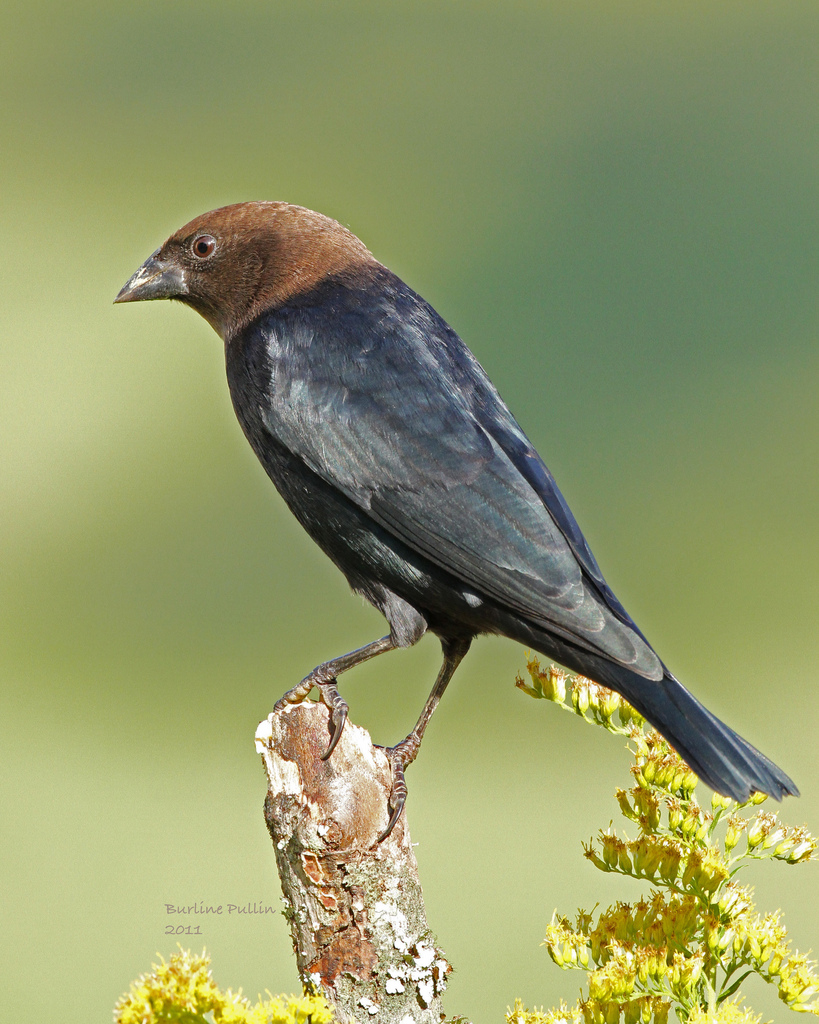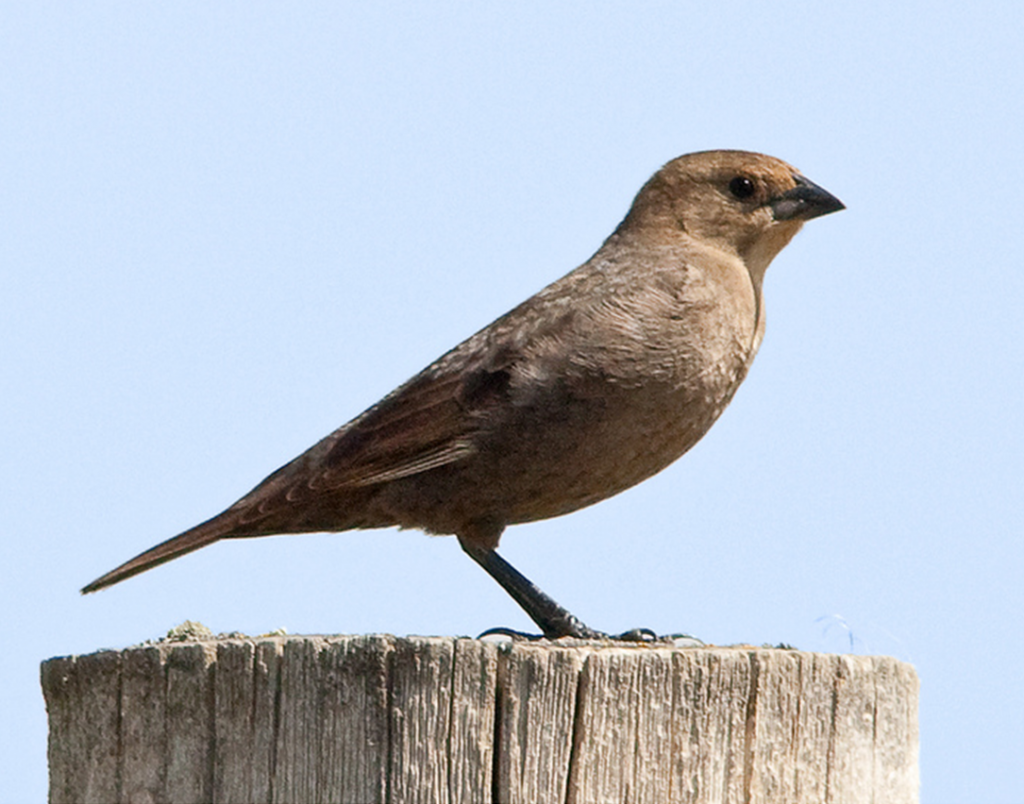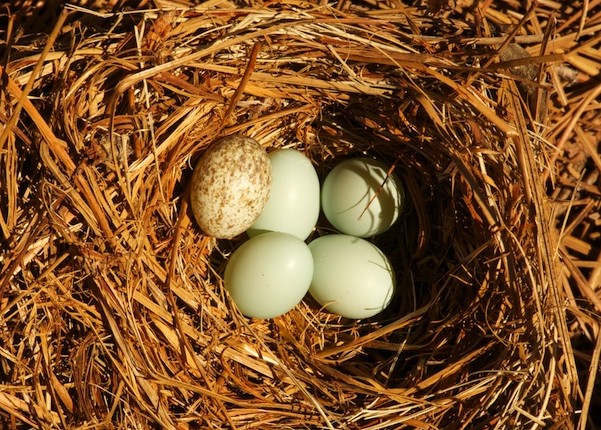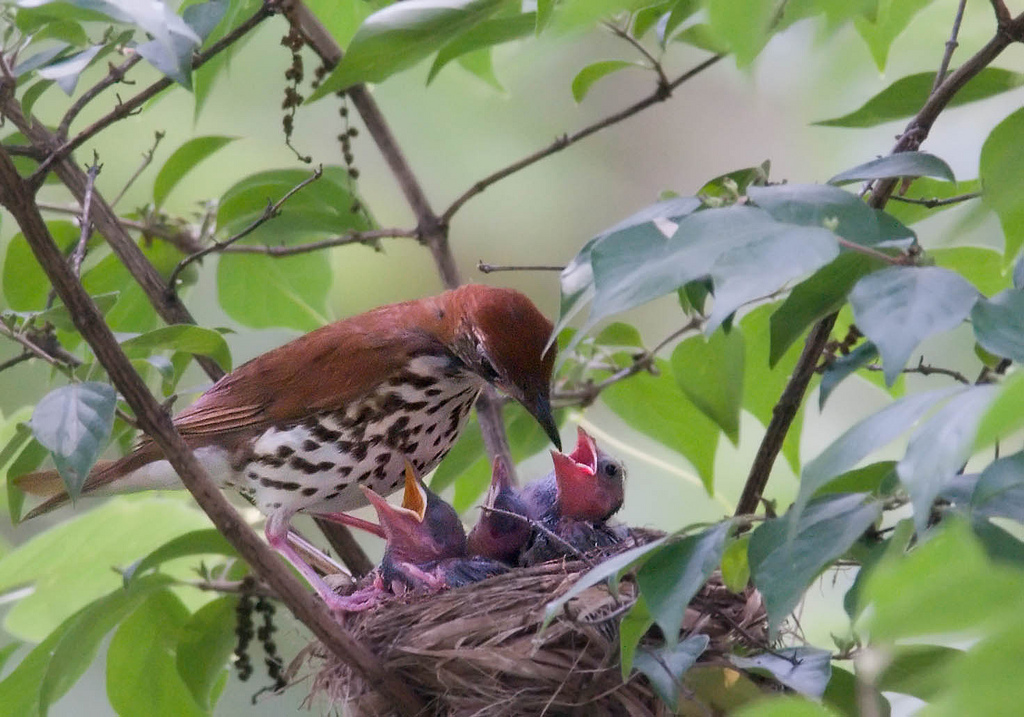What Bird In Michigan Would Lay White Eggs In Garden
 Photo © Darin Ziegler
Photo © Darin Ziegler Brown-headed Cowbirds

Male Brown-headed Cowbird
The Basics
The Brown-headed Cowbird (Molothrus ater) is a brood parasite, meaning that it lays its eggs in nests of other species. A female cowbird quietly searches for female birds of other species that are actively laying eggs. Once she has found a suitable host, the cowbird will sneak onto the resident bird's nest when it is away, usually damage or remove one (or more) egg, and replace that egg with one (or more) of her own (watch a cowbird laying an egg in a Northern Cardinal nest on NestCams). The foster parents then unknowingly raise the young cowbirds, usually at the expense of their own offspring. Cowbird eggs require a shorter incubation period than most other songbirds and thus usually hatch first. Cowbird nestlings also grow large very quickly. These advantages allow them to command the most food from their foster parents, usually resulting in reduced nesting success of the host species.

Female Brown-headed Cowbird
Photo © Raymond Lee Photography
Brown-headed Cowbirds are native to the United States and prefer open grasslands, as well as agricultural, urban, and suburban habitats where grain or cattle-disturbed soil are readily available. Historically they followed herds of bison, eating insects kicked up by the animals' hooves. It is unknown whether they developed their breeding strategy because they had to move frequently to keep up with the bison herds, or whether they were able to follow the herds because their breeding strategy gave them the freedom to do so. Expansion of agricultural areas and removal of forest cover have greatly benefited this species by providing more overall habitat and by giving cowbirds access to new host species that have not developed defensive strategies against nest parasitism. While it is clear that cowbirds have benefited from forest fragmentation, their role in population-level declines of many forest birds is less certain.
A Compound Problem
The cowbird does not depend exclusively on a single host species; it has been known to parasitize over 220 different species of North American birds and therefore spreads its impact across many populations. Although cowbirds have been implicated in the population declines of several rare species, such as Kirtland's Warbler and Black-capped Vireo, habitat loss and fragmentation likely play a much larger role in causing songbird declines. This is evidenced by the fact that cowbird control alone did not increase populations of the endangered Kirtland's Warbler; only when cowbird control was combined with habitat management for young Jack Pine forests did the warblers rebound.
Because cowbirds are native to the U.S., they are protected under the Migratory Bird Treaty Act and in most instances it is unlawful to use lethal control without a permit, including the removal of their eggs from a nest. However, unpermitted control of cowbirds is occasionally permissible under special circumstances outlined in the Migratory Bird Treaty Act. Additionally, in some states, such as Michigan and Texas, permits can be obtained to trap cowbirds to protect endangered species like Kirtland's Warbler, Golden-cheeked Warbler, and Black-capped Vireo. Please check with your state's wildlife management agency for local regulations.
Some species, such as the Yellow Warbler, can recognize cowbird eggs and will reject them or build a new nest on top of them. Those species which accept cowbird eggs either do not notice the new eggs, or as new evidence suggests, accept them as a defense against total nest destruction. Cowbirds may "punish" egg-rejectors by destroying the entire nest, whereas it is possible for egg-acceptors to raise some of their own young in addition to the cowbird young (see Birdscope 2008).

Fledgling Brown-headed Cowbird
This fledgling Brown-headed Cowbird dwarfs the adult Common Yellowthroat acting as dad.
Photo © Darin Ziegler
To deter Brown-headed Cowbirds:
- Use feeders that are made for smaller birds, such as tube feeders that have short perches, smaller ports, and no catch basin on the bottom. Avoid platform trays, and do not spread food on the ground.
- Cowbirds prefer sunflower seeds, cracked corn, and millet; offer nyjer seeds, suet, nectar, whole peanuts, or safflower seeds instead.
- Clean up seed spills on the ground below feeders.
- Don't search for or visit a nest when cowbirds are around.

Parasitized Nest
This cowbird egg (top, left) was laid in an Eastern Bluebird's nest, inside a nest box.
Photo © mcporet_usn

Nestling Brown-headed Cowbird
Note the cowbird (being fed) has a very red gape and has opened its eyes, setting it apart from the Wood Thrush nestlings with whom it shares this nest.
Photo © Kelly Colgan Azar
Odd One Out
How do you know if you have cowbird parasitism to report in your NestWatch data?
- First, look for any eggs that appear different or out of place. Cowbird eggs are sometimes, but not always, larger than those of the host bird. This is especially true of warblers and small birds, but cowbird eggs are the same size as Northern Cardinal eggs.
- Cowbird eggs are white to grayish-white with brown or gray spots or streaks. Many species' eggs resemble cowbird eggs, so you may not be able to tell if the nest is parasitized until after the eggs hatch.
- Look for intact eggs on the ground under active nests. Female cowbirds often evict one or more of the host eggs before they lay their own. However, she may eat the egg instead or damage it and leave it in the nest.
- When nestlings are present, look for a slightly larger nestling that begs vigorously with a bright red "gape" (the brightly colored areas in the corners of a nestling's open mouth). Most songbird chicks have a yellow or pale gape.
- Cowbird young develop in about 8-13 days, so they may fledge before you expect the host species to have fledged. If you accidentally "force fledge" a cowbird, the parents will continue to feed it on the ground. Putting it back in the nest will probably result in the cowbird jumping out again. The parents usually will also continue to feed the young that remain in the nest until they are old enough to leave.
- Fledgling cowbirds are a dull grayish-brown color, and will be nearly their adult size (about the size of a starling), which often means parents will be feeding a youngster larger than themselves.
For additional information about Brown-headed Cowbirds, visit this species' profile on All About Birds.
What Bird In Michigan Would Lay White Eggs In Garden
Source: https://nestwatch.org/learn/general-bird-nest-info/brown-headed-cowbirds/
Posted by: sochahaphe1951.blogspot.com

0 Response to "What Bird In Michigan Would Lay White Eggs In Garden"
Post a Comment